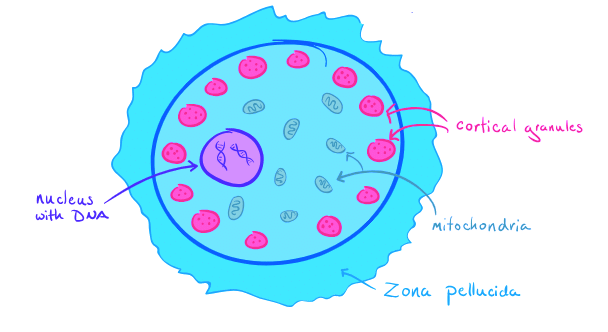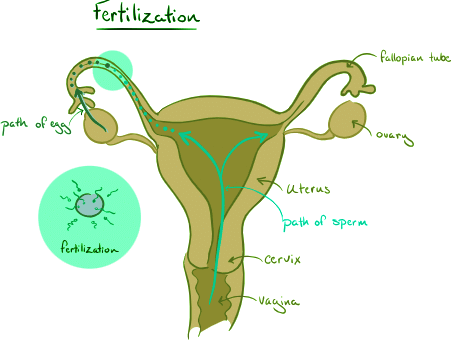MCAT Exam > MCAT Notes > Biology for MCAT > Egg Meets Sperm
Egg Meets Sperm | Biology for MCAT PDF Download
| Table of contents |

|
| Introduction |

|
| The Main Characters: Egg and Sperm |

|
| The Setting: A Journey Through the Female Reproductive System |

|
| The Action: Fertilization and Beyond |

|
Introduction
Every hour, all around the world, a remarkable event unfolds—the meeting of an egg and sperm. Although this phenomenon is a common occurrence, it remains a captivating story worth retelling. In this article, we delve into the intricate journey of these microscopic entities as they embark on a perilous quest to create something truly unique. Join us as we explore the main characters, the setting in which this extraordinary encounter takes place, and the captivating action that unfolds during the moment of fertilization.
The Main Characters: Egg and Sperm
- Zooming in on the protagonists, we encounter the egg and sperm, two fundamental elements in the process of fertilization. The sperm cells, numbering in the hundreds of millions, display a streamlined design tailored for their mission. Equipped with a long tail for propulsion, numerous mitochondria for energy production, genetic information to be passed on, and enzymatic proteins for penetrating the egg cell, the sperm is a marvel of nature. The acrosome, a cap-like structure located at the front of the sperm, contains the proteins responsible for initiating contact with the egg. Once in motion, the tail, known as a flagellum, utilizes energy generated by the mitochondria to propel the sperm forward. Remarkably, the flagella remain dormant until the sperm enter the vagina to conserve energy. Sperm are haploid, meaning they carry only one set of 23 chromosomes. These specialized cells are created through meiosis, a cellular division process that yields four sperm from a single germ cell. In size, sperm are minuscule, measuring a mere 50μm in length. Ejaculated in semen, a basic fluid with a pH of approximately 7.4, sperm embark on their journey toward the egg.
- Conversely, the egg is a significantly larger entity compared to sperm. It serves as a rich source of cytosol, organelles, particularly mitochondria, and other vital components for the future zygote. Unlike sperm, the egg has not completed the meiotic division and remains in the Metaphase II stage. Consequently, the egg is haploid but retains sister chromatids attached to each other. While sperm production results in multiple viable cells, the process of oogenesis yields only one functional egg. Surrounding the egg is a thick outer coating called the zona pellucida, a layer composed of carbohydrate-covered proteins that encases the plasma membrane. Serving as a protective barrier, the zona pellucida plays a crucial role in facilitating the initial meeting between sperm and egg. Inside the egg's cell membrane, cortical granules, filled with enzymes, line the interior. These granules play a vital role in ensuring that only one sperm can fertilize the egg, preventing polyspermy. The egg, with its unique characteristics, sets the stage for the momentous encounter.

The Setting: A Journey Through the Female Reproductive System
- The egg and sperm embark on a journey, traveling in opposite directions, with the ultimate destination being the fallopian tubes. During ovulation, the ovaries release an egg into one of the fallopian tubes, commencing its path towards the uterus, which is prepared for potential implantation. This preparation involves elevated levels of estrogen and luteinizing hormone (LH). LH triggers the release of the egg from the ovaries, while increased estrogen stimulates the vaginal membrane to secrete glycogen, which is metabolized into lactate. This process lowers the vaginal pH, creating an acidic environment hostile to pathogens. However, this acidity can also be detrimental to sperm, which is where semen, a basic fluid, comes into play. Mixing with vaginal secretions, semen buffers the acidity and provides a more favorable environment for sperm motility. Remarkably, only approximately one in a million ejaculated sperm cells will successfully reach the site of fertilization.
- Estrogen's influence extends beyond the vaginal environment. It relaxes the cervix, causes cervical mucus to become watery and more alkaline, and stimulates uterine contractions. These changes facilitate sperm penetration and navigation through the female reproductive system. The relaxed cervix allows sperm to pass from the vagina into the uterus, removing a potential physical barrier. Cervical mucus, which may impede sperm's progress, undergoes significant changes during ovulation. When the egg is released from the ovaries, the mucus becomes thinner and lower in pH, creating an ideal medium for sperm transportation. The uterine contractions not only help push sperm towards the correct fallopian tube, but recent studies suggest that these contractions play a more critical role in sperm movement than the sperm's own propulsion mechanisms. The timing of sperm's progress is intricately linked to the female's menstrual cycle, with greater ease of passage occurring closer to ovulation. These finely balanced mechanisms serve to protect against pathogens while allowing for successful fertilization.
The Action: Fertilization and Beyond
- Assuming that some sperm have overcome the perils of the journey and successfully located the egg, they now face physical and chemical barriers. As the sperm approach the egg, they bind to the zona pellucida, initiating a process known as sperm binding. This triggers the acrosome reaction, releasing the enzymes within the acrosome. These enzymes begin digesting the zona pellucida, enabling the sperm to tunnel toward the egg's plasma membrane. Finally, when the sperm cell reaches the egg, their plasma membranes fuse together, and the sperm releases its genetic material into the egg. Fertilization has now occurred, marking a pivotal moment in the journey.
- The fusion of the sperm and egg not only leads to fertilization but also activates the cortical reaction. This fusion induces the release of calcium ions, triggering the cortical granules inside the egg to merge with the plasma membrane. As they fuse, these granules discharge their contents outside the cell, toward the remnants of the zona pellucida. The enzymes contained within the cortical granules further break down the zona pellucida, rendering it unable to bind additional sperm. Simultaneously, other molecules present in the granules create a new protective layer around the fertilized egg. This cortical reaction acts as a safeguard against polyspermy, ensuring that only one sperm fertilizes the egg. It can be likened to the entrance of a hidden temple, where triggering the reaction renders subsequent attempts futile.

Conclusion
The extraordinary journey of the egg meeting sperm is a testament to the wonders of embryology. Through their respective adaptations and interactions within the female reproductive system, these microscopic entities overcome numerous challenges to unite in the moment of fertilization. From the initial encounter to the intricacies of sperm motility and the cortical reaction, this captivating tale highlights the complex processes that underpin the creation of new life. It is a story worth celebrating, reminding us of the extraordinary beauty and intricacy of nature's design.
The document Egg Meets Sperm | Biology for MCAT is a part of the MCAT Course Biology for MCAT.
All you need of MCAT at this link: MCAT
|
233 videos|16 docs|32 tests
|
Related Searches



















